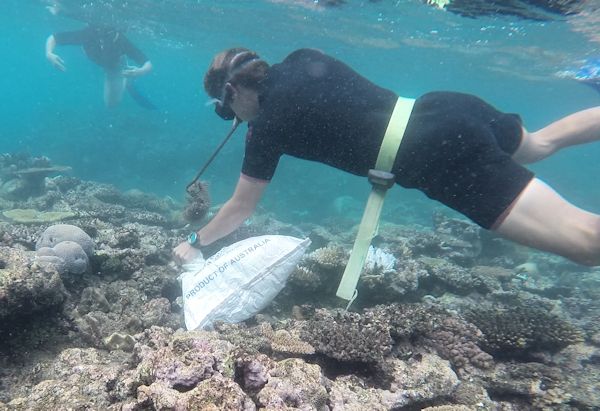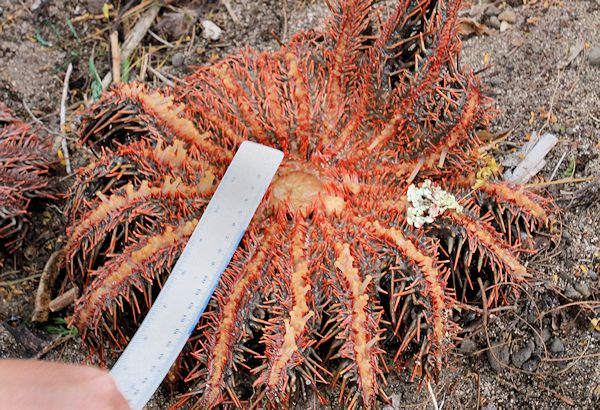Words
and pictures by Richard Moore

IT
WAS a very strange hunt to say the least.
The
prey was in its element, a fearsome beast with multiple
ways to defend itself physically – including spikes and
poison - as well as in-built defensive traps that would
slow down Indiana Jones in his prime.
To
make matters worse this foe can wreak environmental harm
in fragile ecosystems and has no mercy in its desire for
self-preservation.
It
is nature's equivalent to a trigger for nuclear war with
annihilation of its surroundings a key threat.
Sound
a little over the top? Not really when you consider the
enemy was a Crown of Thorns starfish.
 In
a balanced eco-system the Crown of Thorns is surprisingly
beneficial, dealing with fast growing corals that can block
marine channels and take over from slower varieties.
In
a balanced eco-system the Crown of Thorns is surprisingly
beneficial, dealing with fast growing corals that can block
marine channels and take over from slower varieties.
But
in the waters off Fiji, where commercial fishermen have
pillaged stocks of the predators that keep the starfish
under control – such as hump-headed wrass, puffer fish and
grouper - the population has exploded and it is now a major
pest.
And
other creatures that keep the destructive critter at bay
- the Triton’s trumpet and giant clams – have also been
exploited because of their shells and have been unable to
keep the crown of thorns at bay.
This
could be disastrous for the Yasawas economy as 90 per cent
of the islands’ liquid income comes from tourism and the
tourists who come to snorkel, dive and enjoy the beautiful
reefs of the area.
At
the resort of Barefoot Manta on Drawaqa Island in the Yasawa
Islands, it is a daily effort by the marine biology team
led by Dan Bowling and Heather Pacey to try to reduce the
menace.
Teams
of resort staff and volunteers from among the guests go
on head out each day to under-threat reefs to physically
remove the creatures.
I
join in on the hunt going to North Botera reef, about 5km
from the resort, and using snorkeling gear act as a novice
spotter for the divers.
It
is a worthwhile cause and a really enjoyable one.
Swimming over the reef with mask and fins on you are told
to look out for the tell-tale signs of crown of thorns predation
and that is patches of bleached coral. That is coral destroyed
by the starfish.
The
way in which the coral polyps are killed is not pleasant
and is just one more reason to dislike this nasty little
beast. The starfish’s stomach is extended out through its
mouth to cover an area of coral about the size of itself.
Then it secretes enzymes that liquify polyps so it can drink
them like soup.
One
starfish can destroy up to 10 square metres of coral a year.
No
wonder it is such a menace in big numbers. Now finding the
starfish as a beginner isn't an easy task, they hide in
crevices amid their victims-to-be, and it is only after
you have seen a couple that you start to recognize them
more easily.
They
are mean looking and you can just tell from vicious venomous
spikes that protrude from them that they are the bad guys
of the reef.
Even
armed with an angled steel rod you need to be careful removing
the starfish as if a female’s skin is punctured it will
release 50 million eggs to saturate the area with new versions
of itself.
If
it is killed a similar explosion occurs.
And do not split them in half as that doubles the problem
as the beast becomes two independent monsters.
So
the hunters carefully pull them out of the coral and place
them in bags to be taken to the surface to meet their end.
Even
there care is needed as the spikes can prick skin through
the carry sacks leaving painful, infected punctures that
hurt for days.
And
the remains need to be disposed of carefully – on land so
they won't reproduce - and away from plants as their extreme
salt levels are toxic.
The
resort staff bury them in shallow sandy graves in an area
set aside for their cemetery.
Before they are unceremoniously dumped into the hole the
starfish are measured for population studies and then the
tossing begins.
Marine biologist Dan Bowling says with a slight wry smile
that some people say a few words over them as they are being
covered.
“If they come back, we hope it is as angel fish.”
Richard
Moore was in Fiji courtesy of Barefoot Manta Resort, Awesome
Adventures Fiji and Vinaka Fiji.



